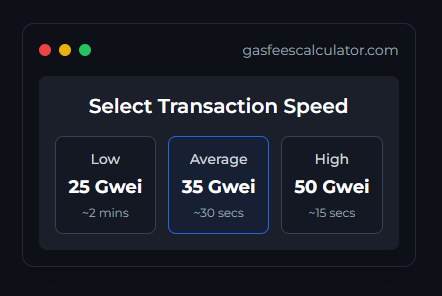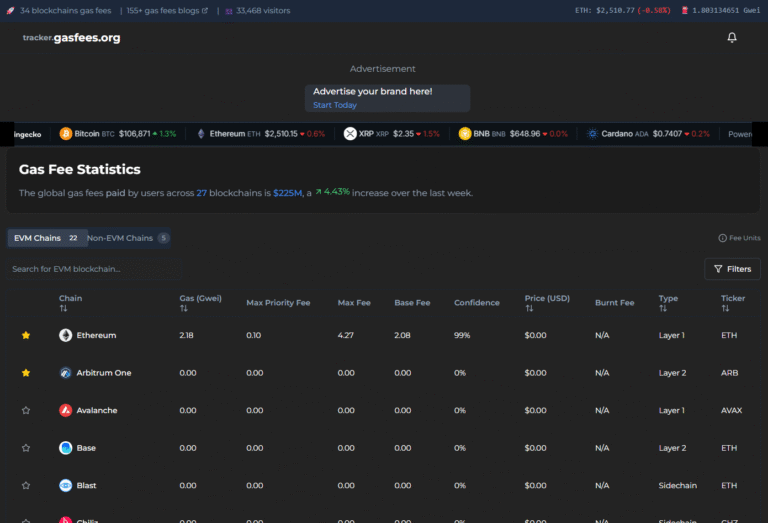Gas Fees Got You Down Discover How to Keep More Crypto in Your Pocket
Understanding Gas Fees in Crypto
When diving into the world of cryptocurrencies, one term you’ll frequently encounter is gas fees. These fees are a fundamental aspect of several blockchain networks, especially Ethereum, which often leaves beginners scratching their heads wondering what exactly they are paying for. So, let’s break it down in an easy-to-understand way.
Gas fees are essentially transaction charges that users pay to miners or validators as a way to compensate them for the computational energy required to process and validate transactions on the blockchain. Think of it as the toll you pay to use a highway; in this case, the blockchain is the highway and your transaction is the vehicle.
Why does the price vary? Just like fuel prices, gas fees can fluctuate widely. They are determined by several factors, including network congestion. The more people trying to make transactions, the higher the gas price, as users bid more to get their transactions processed faster.
- Pro-tip: To save on gas fees, consider transacting during off-peak hours when the network is less congested.
In essence, gas fees are a vital part of ensuring that blockchain networks keep running smoothly. They not only incentivize miners and validators but also help regulate the flow of transactions, avoiding spam and ensuring your crypto transactions are processed in a secure and timely manner. Understanding gas fees is crucial for anyone looking to interact with the blockchain efficiently while managing costs.
Wallet Management: Minimizing Gas Fees
When venturing into the world of cryptocurrencies, managing gas fees efficiently becomes as crucial as securing your digital assets. Gas fees, the transaction fees paid to miners on a blockchain like Ethereum, can significantly impact your wallet’s health, especially during peak network congestion times. Here’s how you can smartly reduce these fees without compromising on your blockchain activities.
First off, timing is everything. Most blockchains have predictable patterns of high and low activity. Engage in transactions during off-peak hours to benefit from lower fees. Websites and apps that track gas fees in real-time can be your best friends in planning transactions.
Another pro tip is to leverage gas tokens. These tokens are designed to store gas when it’s cheap and utilize it when gas prices spike, acting as a cushion against fluctuating fees.
Opting for Layer-2 solutions is a game-changer. These solutions, or sidechains, process transactions off the main Ethereum chain, drastically bringing down the gas cost. Not all services support these yet, but the trend is growing.
Lastly, when you’re about to confirm a transaction, don’t overlook the gas limit and Gwei price settings in your wallet. Adjusting these carefully can help you save on fees without risking transaction failure. Setting too low a gas limit can result in failed transactions, while too high a Gwei price could mean overpaying for the transaction to be processed.
By adopting these strategies, you not only ensure efficient wallet management but also safeguard your digital assets from eroding through excessive fees. Remember, in the dynamic world of cryptocurrencies, staying informed and adaptable to new tools and practices is key to maximizing your investments.
Keep these pointers in mind, and you’ll navigate the complex waters of gas fees with confidence and efficiency. Happy trading!
Choosing the Right Blockchain for Low Gas Fees
In the world of cryptocurrency and blockchain technology, the matter of gas fees can often be a deciding factor in which network individuals choose to conduct their transactions. Gas fees are essentially transaction fees paid to miners or validators for processing transactions and securing the blockchain. With the rise of digital assets, choosing a blockchain with low gas fees without compromising on security or speed is becoming increasingly crucial.
One key to finding a blockchain that offers low gas fees is to look towards newer, more efficient networks. Ethereum 2.0, for instance, promises significant improvements in scalability and gas efficiency through its shift to a proof-of-stake consensus mechanism. However, while Ethereum undergoes its transformation, other blockchains like Solana, Cardano, and Binance Smart Chain (BSC) have emerged as frontrunners in the race for efficiency and cost-effectiveness.
- Solana stands out for its incredibly high throughput and low transaction costs, powered by its innovative proof-of-history (PoH) consensus.
- Cardano offers a unique proof-of-stake mechanism that emphasizes security and scalability, aiming to provide low fees alongside high transaction speeds.
- Binance Smart Chain is recognized for its compatibility with Ethereum smart contracts while offering significantly lower transaction fees, making it an attractive alternative for developers and users alike.
It is crucial, however, to not just focus on the cost. Ensuring that the blockchain you choose aligns with your security, scaling needs, and the community support is equally important. Remember, the right blockchain for you balances low gas fees with robust features and a thriving ecosystem. Dive into each blockchain’s community forums, technical documentation, and current user experiences to make an informed decision that suits your needs the best.
Evaluating Gas Fees on DeFi Platforms
When diving into the universe of Decentralized Finance (DeFi), one can’t help but encounter the term gas fees. These fees are vital to understanding how DeFi platforms operate and, more importantly, how they impact your transactions. Think of gas fees as the fuel that powers transactions on the Ethereum network, a common foundation for many DeFi projects. However, they aren’t exclusive to Ethereum; several other blockchains also adopt similar concepts.
Gas fees fluctuate based on demand within the network. The busier the network, the higher the fee. This can significantly affect the cost-effectiveness of transactions, especially when the network is congested. Here are a few tips on how to evaluate these fees for a smoother DeFi experience:
- Understand the Market Dynamics: Gas fees rise and fall. Conducting transactions during off-peak hours can lead to lower fees.
- Use Gas Trackers: Websites and apps are available that track gas fees in real-time, helping you decide the best time to make a transaction.
- Transaction Type Matters: Simple transactions like token transfers usually cost less in gas than complex contract interactions. Keep this in mind when planning your DeFi activities.
- Keep an Eye on Updates: DeFi platforms and Ethereum itself are continuously updated. Some updates aim to reduce gas fees or improve efficiency.
In essence, while gas fees might seem like a small part of the DeFi puzzle, they play a crucial role in the ecosystem’s accessibility and efficiency. By staying informed and strategically planning your transactions, you can navigate the DeFi waters more smoothly, making the most of what these innovative platforms have to offer. Remember, in the world of DeFi, knowledge is not just power—it’s also savings!
Optimizing Gas Fees in NFT Transactions
Navigating the world of Non-Fungible Tokens (NFTs) can be both exhilarating and, at times, a little wallet-draining, especially when it comes to gas fees. Gas fees are essentially the transaction fees that users pay to miners on a blockchain protocol to have their transactions included in the block. In the context of NFTs, whether you’re minting, buying, or selling, understanding how to optimize these fees can make a big difference in your overall experience and expenditure.
Why Gas Fees Can Fluctuate: Gas fees can be volatile, primarily because they are determined by two main factors: the complexity of the transaction and the current demand on the network. NFT transactions, particularly minting, can be complex and thus more costly.
Tips for Gas Fee Optimization:
- Timing is Key: Gas fees fluctuate throughout the day based on network congestion. Consider executing transactions during off-peak hours to potentially benefit from lower fees.
- Batch Transactions: If you’re minting multiple NFTs, doing so in a single transaction can significantly reduce the gas cost per NFT.
- Use Gas Trackers: Tools like ETH Gas Station and Gas Now can help you monitor gas prices in real-time, letting you choose the best times to transact.
- Opt for a Layer 2 Solution: Exploring NFT platforms that operate on Layer 2 solutions (like Polygon or Immutable X) can offer lower gas fees while still securing your assets on the Ethereum network.
Remember, while optimizing your gas fees might require some patience and research, it’s a vital step towards making your NFT journey more enjoyable and less costly. Armed with these strategies, you can navigate the NFT landscape like a pro, making smarter decisions that benefit both your experience and your wallet.
Ethereum vs. Binance Smart Chain: A Gas Fee Showdown
When delving into the world of cryptocurrencies and blockchain, one can’t overlook the significance of gas fees. These fees are essential for conducting transactions and smart contract operations. Two powerhouses in the blockchain realm, Ethereusm and Binance Smart Chain (BSC), often come under scrutiny for their gas fee structures. Let’s break down what makes them distinct and draw some comparisons.
Ethereum, known as the pioneer of smart contracts, operates on a system where gas fees fluctuate based on network congestion. This means during peak times, transactions can become pricier as more users vie for their transactions to be processed. Historically, during massive token sales or NFT drops, Ethereum’s gas fees have skyrocketed, sometimes making small transactions unfeasible.
On the flip side, Binance Smart Chain flaunts its ability to offer significantly lower transaction fees compared to Ethereum. BSC achieves this by a different consensus mechanism (Proof of Staked Authority) that allows for high transaction throughput and lower fees. This makes it an attractive option for users seeking cheaper and faster transactions, albeit at the trade-off of decentralization compared to Ethereum.
So, which blockchain wins the gas fee battle? It depends on your priorities. If decentralization and security are your top concerns, Ethereum might be worth the extra cost. However, for those prioritizing speed and low fees, Binance Smart Chain could be the more appealing option.
Both blockchains have their merits and serve distinct niches within the broader crypto ecosystem. As always, perform due diligence before engaging in transactions to ensure that the chosen blockchain aligns with your needs and values.
Maximizing Efficiency: Strategies for Gas Fee Savings in Crypto Transactions
In the evolving landscape of cryptocurrency, gas fees—the transaction fees that users pay to miners on a blockchain protocol to have their transaction included in the block—can be a significant concern. As the crypto space grows, so does the urgency for savvy strategies to minimize these fees. Here are some insightful tips to navigate this aspect more economically.
Choose the Right Time: Much like traditional market trends, the cost of gas fees fructifies depending on network demand. Engaging in transactions during off-peak hours can lead to substantial savings. Tools and websites that track gas fees in real-time can be invaluable for timing your transactions just right.
Leverage Low Gas Platforms: Not all blockchains charge the same rates. Exploring cryptocurrencies that operate on networks known for lower transaction fees might offer a cost-effective alternative. Remember, the Ethereum network is renowned for higher fees, especially during network congestion. Looking towards alternatives like Binance Smart Chain or Solana might provide a more economical approach.
Batch Transactions: If possible, consolidating operations into a single transaction can considerably reduce costs. Complex operations like swapping tokens or yield farming often involve multiple transactions. Some platforms allow these to be batched together, slashing the total gas fees required.
Gas Tokens: Certain projects have introduced gas tokens, which can be minted when gas prices are low and redeemed to cover fees when they are high. This speculative strategy takes advantage of the volatility of gas prices and could lead to savings.
Opt for SegWit Addresses: If you’re transacting in Bitcoin, using SegWit addresses can lower transaction fees. These addresses allow for more transactions per block, thus reducing the cost associated with each transaction.
In a nutshell, while navigating the realm of cryptocurrency, a strategic approach to managing gas fees can lead to significant savings, enhancing your overall investment strategy. Armed with knowledge and the right tools, you can optimize your transactions to be as cost-effective as possible. Remember, in the dynamic world of crypto, staying informed and adaptable is key to maximizing your assets.
The Future of Gas Fees in Crypto Market
As we navigate through the ever-evolving landscape of the cryptocurrency market, one of the hot topics that continue to spark debates is the future of gas fees. With the blockchain industry aiming for mass adoption, the scalability concern and high transaction costs are hurdles that need immediate addressing.
First off, understanding what gas fees are is crucial. They are essentially transaction fees on a blockchain network, predominantly discussed in the context of Ethereum. These fees compensate miners or validators for the energy and resources expended to validate and record transactions on the blockchain. But here’s the thing, as more people join the blockchain bandwagon, these fees can skyrocket, sometimes making smaller transactions economically unviable.
However, there’s a glimmer of hope. With the advent of Ethereum 2.0, which introduces proof-of-stake (PoS), and the increasing adoption of layer 2 scaling solutions like Optimism and Polygon, the future looks promising. These innovations aim to drastically reduce the gas fees while increasing transaction throughput, making blockchain more accessible.
“The future of gas fees in the crypto market is not just a matter of reducing costs but enhancing the blockchain ecosystem’s efficiency and inclusivity.”
Moreover, the rise of alternative blockchain platforms with inherently low transaction costs is prompting a competitive landscape that could drive down fees across the board. These blockchains design their consensus mechanisms and scalability solutions from the ground up to minimize transaction costs.
In conclusion, while predicting the exact trajectory of gas fees can be challenging, the concerted efforts from the community and technological advancements paint a hopeful picture. Lower, more predictable gas fees would not only improve the user experience but also pave the way for new applications and use cases, solidifying blockchain’s role in the digital economy.





